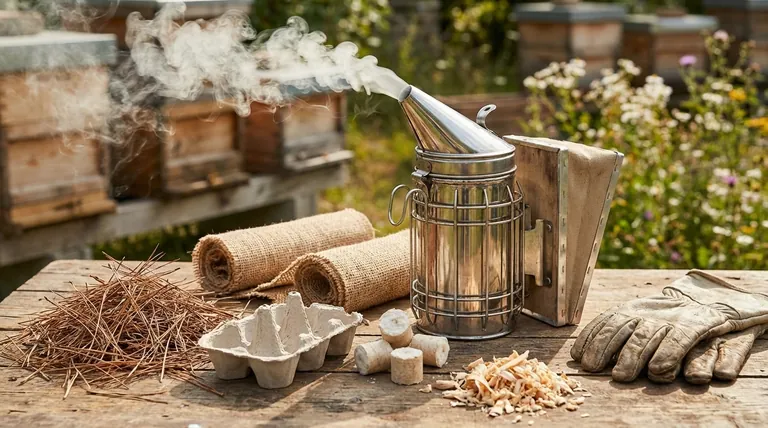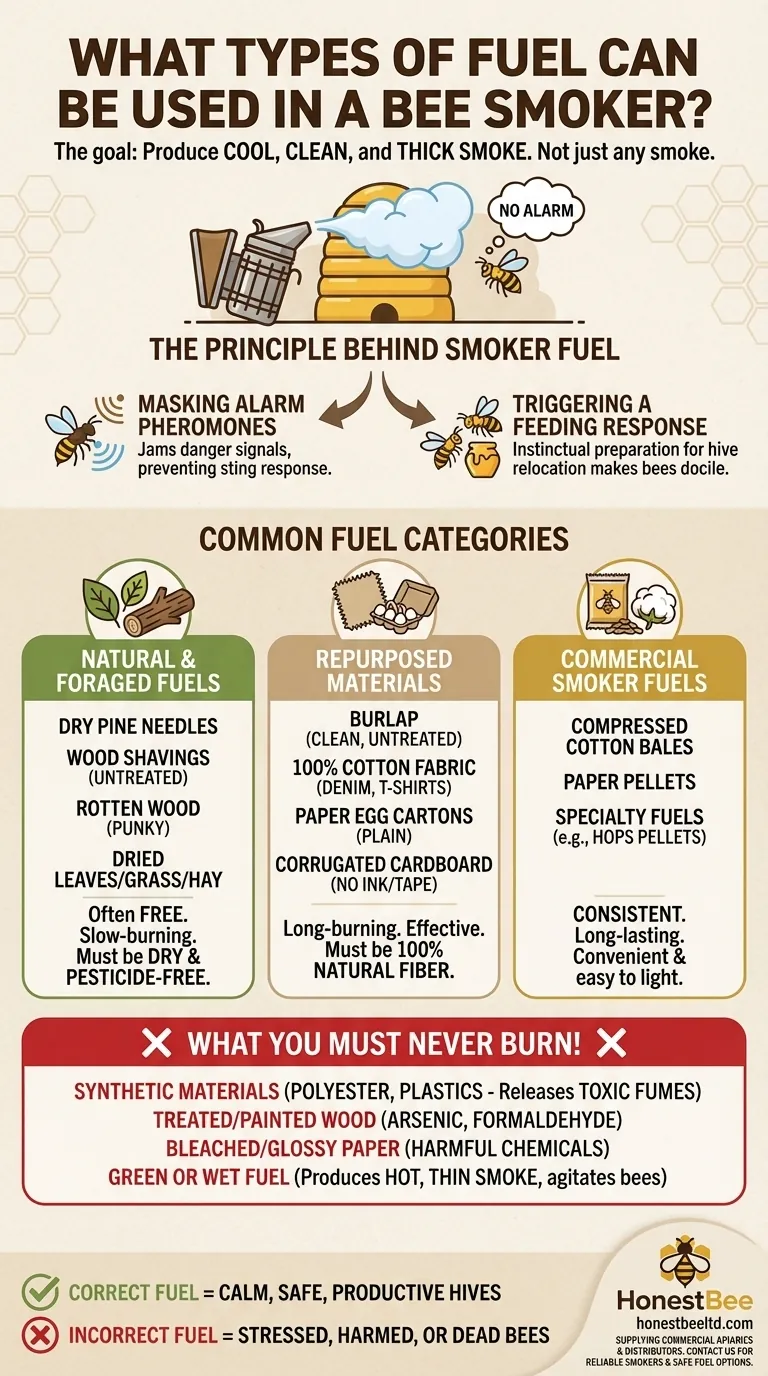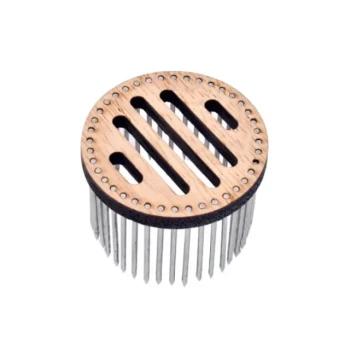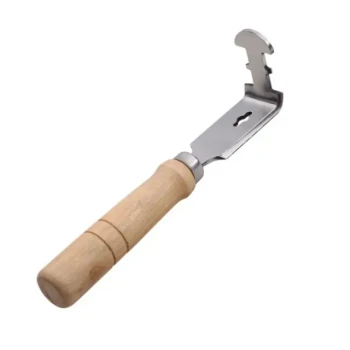The short answer is that a wide variety of natural and unprocessed materials can be used as fuel in a bee smoker. The best options include dry pine needles, wood shavings, untreated burlap, 100% cotton fabric, paper egg cartons, and commercially prepared smoker fuels. The key is to select a material that burns slowly and produces a cool, thick, and non-toxic smoke.
The goal of a smoker is not simply to create smoke, but to produce cool, clean smoke that masks bee alarm pheromones without causing them harm or stress. Therefore, the ideal fuel is always natural, untreated, and slow-burning.

The Principle Behind Bee Smoker Fuel
The smoke from a bee smoker serves a specific biological purpose. It interrupts the bees' primary method of communicating danger, allowing a beekeeper to inspect the hive without triggering a full-scale defensive response.
Masking Alarm Pheromones
When a bee feels threatened, it releases alarm pheromones. This chemical signal alerts other bees in the colony to a potential threat, preparing them to sting. The thick smoke from a smoker effectively "jams" this signal by overwhelming the bees' sensitive olfactory receptors, preventing the alarm from spreading.
Triggering a Feeding Response
Smoke also initiates a secondary, instinctual response in bees. They associate heavy smoke with a potential forest fire, which would threaten their hive. In response, they begin consuming honey to prepare for a possible relocation, making them more docile and less inclined to fly out and sting.
A Breakdown of Common Fuel Types
The best fuel is often a combination of a quick-lighting starter and a slower-burning main fuel source. They generally fall into three categories.
Natural, Foraged Fuels
These fuels are often free and readily available around your property. They are excellent choices as long as they are completely dry and free of pesticides or chemical treatments.
- Pine Needles: A classic choice. They are easy to light and produce a pleasant-smelling, gentle smoke.
- Wood Shavings or Pellets: Untreated wood shavings (not MDF or particleboard dust) burn slowly and consistently. Hardwood pellets for grilling can also work if they contain no chemical additives.
- Rotten Wood: Soft, "punky" wood that is dry and crumbly smolders for a very long time, producing excellent cool smoke.
- Dried Leaves, Grass, or Hay: These work well but can burn quickly. They are best when packed tightly or mixed with slower-burning fuels.
Repurposed Household & Agricultural Materials
Many common items can be repurposed as smoker fuel, provided they are made from 100% natural, untreated fibers.
- Burlap (Hessian Fabric): A traditional favorite among beekeepers. Strips of clean, untreated burlap bags smolder perfectly.
- 100% Cotton Fabric: Old denim jeans or cotton T-shirts, cut into strips, are a fantastic long-burning fuel. Ensure they are not synthetic blends.
- Paper Egg Cartons: The molded cardboard from egg cartons is easy to light and smolders well. Avoid cartons with plastic labels or heavy ink.
- Corrugated Cardboard: Rolls of cardboard with no ink or tape can be used as a starter or main fuel, but can sometimes burn too quickly.
Commercial Smoker Fuels
For convenience and consistency, many beekeepers opt for commercially prepared fuels.
- Compressed Cotton: This is one of the most popular commercial fuels. It comes in bales, lights easily, and smolders for a very long time.
- Paper Pellets: These are made from pulped, compressed paper and offer a very consistent and long burn time.
- Specialty Fuels: Some products, like pellets made from dried hops, are noted for producing an especially calming smoke due to natural compounds like lupulin.
Understanding the Trade-offs and Dangers
Your choice of fuel has direct consequences for the health of your bees and the success of your inspection. Choosing incorrectly can be harmful.
What You Must NEVER Burn
Burning the wrong material can release toxic fumes that will stress, poison, or kill your bees. Never use:
- Synthetic materials: Polyester, nylon, or any plastic-based fabric will melt and release toxic chemicals.
- Treated or painted wood: Pressure-treated wood, particleboard, MDF, and painted or varnished wood contain arsenic, formaldehyde, and other poisons.
- Bleached or glossy paper: Office paper, magazines, and junk mail contain bleach, clays, and chemicals in their inks that are harmful to bees.
- Green or wet fuel: Damp fuel produces a hot, steamy smoke that is ineffective and agitates bees. All fuel must be thoroughly dry.
The Problem with Hot, Thin Smoke
The goal is cool, thick smoke. A fuel that burns too hot or too fast can actually harm your bees' delicate wings and bodies. Fast-burning fuels also produce thin smoke that fails to adequately mask pheromones, making your efforts less effective. A good fuel smolders, it doesn't flame.
Combining Starters and Main Fuel
For an efficient process, use a two-stage approach. Use a fast-lighting starter material like a small piece of newspaper or cardboard to establish a coal bed at the bottom of the smoker. Then, add your slower-burning main fuel, like cotton or wood shavings, on top to smolder and produce smoke for the duration of your inspection.
Making the Right Choice for Your Goal
Your ideal fuel depends on your priorities, budget, and what is readily available to you.
- If your primary focus is cost-effectiveness and sustainability: Rely on foraged materials like dry pine needles, rotten wood, or repurposed, untreated burlap and cardboard.
- If your primary focus is convenience and reliability: Purchase commercial smoker fuels like compressed cotton or specialty pellets for a consistent, long-lasting, and easy-to-light option.
- If you are performing a very quick hive check: A simple piece of a paper egg carton or a commercial fuel log may provide all the smoke you need without requiring a long-burning main fuel.
By selecting a clean, cool-burning fuel, you ensure every interaction with your hive is calm, safe, and productive for both you and your bees.
Summary Table:
| Fuel Type | Examples | Key Characteristics |
|---|---|---|
| Natural & Foraged | Pine Needles, Wood Shavings, Rotten Wood | Free, slow-burning, produces cool smoke. Must be dry and untreated. |
| Repurposed Materials | Burlap, 100% Cotton Fabric, Cardboard Egg Cartons | Long-burning, effective. Must be 100% natural fiber with no chemicals. |
| Commercial Fuels | Compressed Cotton, Paper Pellets | Consistent, convenient, long-lasting, and easy to light. |
| NEVER Use | Synthetic Fabrics, Treated/Painted Wood, Glossy Paper | Releases toxic fumes that are harmful or fatal to bees. |
Ensure your beekeeping operations run smoothly with the right equipment. HONESTBEE supplies high-quality beekeeping supplies and equipment, including reliable smokers and safe fuel options, to commercial apiaries and distributors. Our wholesale-focused operations ensure you get the durable, effective gear you need to maintain healthy, productive hives.
Contact HONESTBEE today to discuss your supply needs and discover how we can support your business.
Visual Guide

Related Products
- 54-Piece Smoker Fuel Pellets for Beekeeping Beehive Smoker Fuel
- European Stainless Steel Bee Smoker for Honey Bee Hive
- Miniature Stainless Steel Bee Smoker for Beekeeping
- Premium Traditional Copper Bee Smoker with Bellows
- Stainless Steel Honey Bee Smoker Hive and Honeycomb Smoker for Beekeeping
People Also Ask
- How should you start the fire in a bee smoker? A Step-by-Step Guide for a Calm Hive
- What is used in a bee smoker? Master the Best Fuels for Calm, Healthy Hives
- What are important considerations when choosing smoker fuel? A Guide to Safe, Effective Beekeeping
- What fuels are recommended for beehive smokers? Master the Art of Calm, Controlled Inspections
- What is best to burn in a bee smoker? Master the Layered Fuel Technique for Calm Hives



















